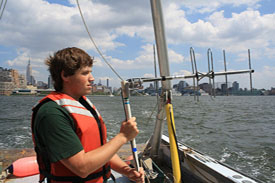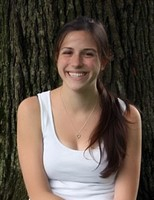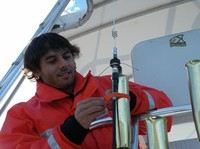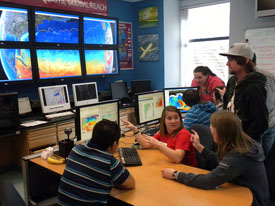Opportunities for cutting-edge research and travel, and being treated like professional colleagues had something to do with it

Danielle Holden, David Kaminsky, Shannon Harrison, and Nilsen Strandskov came to Rutgers at varying levels of cluelessness about their futures. Within a short time, they were doing real science – finding answers to questions that hadn’t been asked before and doing things they hadn’t dreamed of.
Along the way, they also went places – including the Azores, Australia, Norway, and California. The students worked on the Atlantic Crossing project, led by Scott Glenn, professor of marine science in the Institute of Marine and Coastal Sciences, which eventually sent the first submersible robot glider across the Atlantic Ocean in 2009.
The glider observes the ocean in near-real time, gleaning valuable information for oceanographers.

Holden, class of 2011, has begun studying for her master’s degree in maritime systems at the Stevens Institute of Technology in Hoboken. As seniors in Rutgers’ School of Environmental and Biological Sciences, Kaminsky, Strandskov, and Harrison are working on the Challenger Mission, which seeks to deploy gliders around the world, a worldwide project in which Rutgers plays a leading role.
The four came to marine science by varied routes. A friend, Emily Rogalsky, told Holden about an unusual marine science course she was taking, “Special Problems in Oceanography.” Holden visited the class, was intrigued, and signed up.
Strandskov’s father urged his son to be practical in picking his first-year classes. “He wanted me to take some business courses,” Strandskov remembered. “So, I thought, ‘What’s the farthest thing from business?’And I signed up for Peter Rona’s “Introduction to Oceanography.”
Rona is one of the world’s leading geological oceanographers, credited with the discovery of the first seafloor hydrothermal field in the Atlantic Ocean. His work was featured in the award-winning IMAX film, Volcanoes of the Deep, in 2003.
Strandskov knew nothing of this; but he took a Byrne First Year seminar with Rona on careers in oceanography, and was hooked.
Harrison and Kaminsky expected to be studying oceanography from the start, but they didn’t really expect to be doing it. “I was surprised that they actually let me, a freshman, work on glider projects,” said Harrison, who also took Rona’s class and, like Strandskov, was working on an ocean observatory almost before she knew the meaning of the term.
Kaminsky took a class with Glenn called “Communicating Ocean Science,” in which Glenn talked about his glider project. Kaminsky, curious, asked for more information. “By the end of that day, I was starting to work on satellite data,” Kaminsky remembered.

This sequence of events was old news for Rona, who has taught both the basic course and a Byrne seminar “Oceans of Opportunity” for several years and works with Glenn to recruit enthusiastic students to work in the Coastal Ocean Observation Lab room and the glider lab.
The scientists were glad to get Kaminsky, Harrison, Strandskov,

Rogalsky, and Holden: What they were trying to do had never been done, and they needed all the brains, energy, and bodies they could get.
The students worked on different parts of the project at different times, and many of those tasks had never been done before, since no one had ever sent a glider across the ocean before. Battery packs had to be built from scratch, and other internal parts configured. Once the glider was underway, the students helped interpret the data it sent back, plus satellite and high-frequency radar data, to make navigation decisions. They were all surprised at how much responsibility they were given. There were times when Glenn, his colleagues, and the students were just all scientists together, asking questions for which they didn’t yet have answers.
“There were a lot of times when Scott just looked at us and said, ‘Well, you guys do it, you guys decide what to do,’” Harrison said. “There were times when he just gave us the keys and told us to drive.”